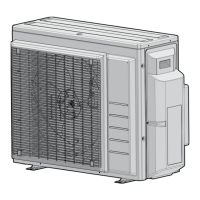Do you have a question about the Daikin 4MXM80A2V1B and is the answer not in the manual?
General safety guidelines for installation, handling warnings, and legal compliance.
Requirements for selecting a suitable installation site, ventilation, and avoiding hazardous locations.
Specific warnings and precautions for handling R32 refrigerant due to its flammability.
Precautions and guidelines for handling refrigerants, including R32, and compliance with legislation.
Safety precautions for electrical work, including wiring, grounding, and power supply.
Safety instructions for handling the outdoor unit, avoiding contact with air inlets or fins.
Safety guidelines for unit installation, material choice, and legal compliance.
Safety warning about leaving the unit unattended with the service cover removed.
Precautions for piping and joints, brazing, welding, and handling refrigerant hazards.
Wiring safety, earthing, fuses, breakers, wire types, and cord replacement.
Choosing an installation location with sufficient space and avoiding dusty work areas.
Spacing guidelines for outdoor unit installation, airflow, and working space.
Precautions for connecting piping, using flare nuts, oil, and avoiding re-use of joints.
Piping connection rules: no mineral oil, use designated refrigerant, secure piping.
Precautions for leak checks, vacuum pumps, and valve status.
Procedure for connecting cylinder, charging, and opening gas stop valve.
Wiring safety, earthing, fuses, breakers, wire types, and cord replacement.
Safety precautions during commissioning, including electrical and mechanical hazards.
Comprehensive checklist for verifying installation before commissioning.
Safety precautions for maintenance: electrical, thermal, and electrostatic discharge risks.
Precautions when servicing the compressor: grounding, power off, safety gear.
Safety precautions during troubleshooting: disconnect power, check safety devices.
Troubleshooting common symptoms like unit failure, vibration, or noise.
Diagnosing problems using LED indicators on the outdoor unit PCB.
General safety guidelines for installation, handling warnings, and legal compliance.
Requirements for selecting a suitable installation site, ventilation, and avoiding hazardous locations.
Specific warnings and precautions for handling R32 refrigerant due to its flammability.
Precautions and guidelines for handling refrigerants, including R32, and compliance with legislation.
Safety precautions for electrical work, including wiring, grounding, and power supply.
Safety instructions for handling the outdoor unit, avoiding contact with air inlets or fins.
Safety guidelines for unit installation, material choice, and legal compliance.
Safety warning about leaving the unit unattended with the service cover removed.
Precautions for piping and joints, brazing, welding, and handling refrigerant hazards.
Wiring safety, earthing, fuses, breakers, wire types, and cord replacement.
Choosing an installation location with sufficient space and avoiding dusty work areas.
Spacing guidelines for outdoor unit installation, airflow, and working space.
Precautions for connecting piping, using flare nuts, oil, and avoiding re-use of joints.
Piping connection rules: no mineral oil, use designated refrigerant, secure piping.
Precautions for leak checks, vacuum pumps, and valve status.
Procedure for connecting cylinder, charging, and opening gas stop valve.
Wiring safety, earthing, fuses, breakers, wire types, and cord replacement.
Safety precautions during commissioning, including electrical and mechanical hazards.
Comprehensive checklist for verifying installation before commissioning.
Safety precautions for maintenance: electrical, thermal, and electrostatic discharge risks.
Precautions when servicing the compressor: grounding, power off, safety gear.
Safety precautions during troubleshooting: disconnect power, check safety devices.
Troubleshooting common symptoms like unit failure, vibration, or noise.
Diagnosing problems using LED indicators on the outdoor unit PCB.
| Model | 4MXM80A2V1B |
|---|---|
| Cooling Capacity | 8.0 kW |
| Heating Capacity | 9.0 kW |
| Seasonal Energy Efficiency Ratio (SEER) | 6.1 |
| Refrigerant | R-32 |
| Maximum Number of Connectable Indoor Units | 4 |
| Type | Multi Split System |
| Power Supply | 220-240V, 50Hz |
| Outdoor Unit Noise Level | 48 dB(A) |
| Indoor Unit Compatibility | Compatible with various Daikin indoor units |











